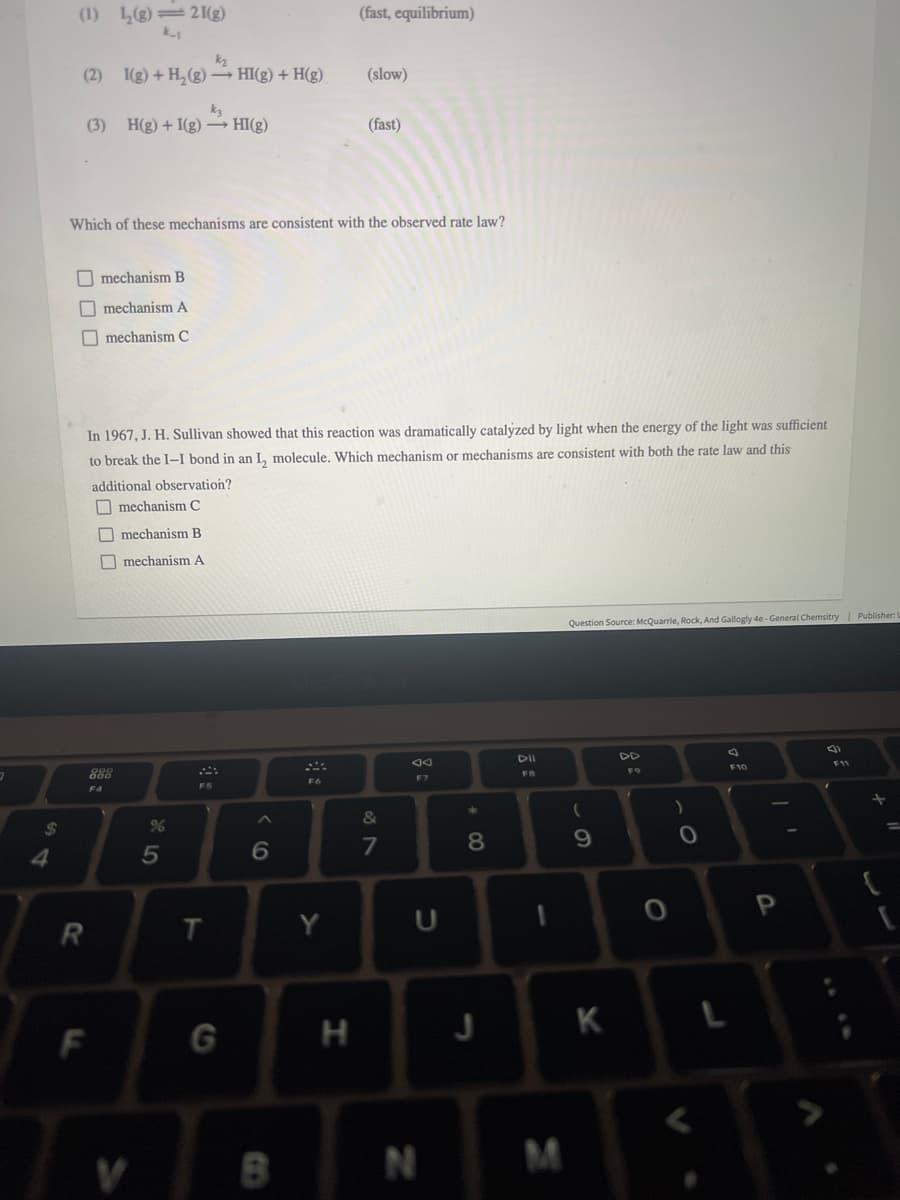(1) L(g)=21(g) k- (fast, equilibrium) k2 (2) I(g) +H,(g) HI(g) + H(g) (slow) k3 (3) H(g) + I(g): HI(g) (fast) Which of these mechanisms are consistent with the observed rate law? mechanism B mechanism A mechanism C In 1967, J. H. Sullivan showed that this reaction was dramatically catalyzed by light when the energy of the light was sufficient to break the I-I bond in an L, molecule. Which mechanism or mechanisms are consistent with both the rate law and this additional observation? mechanism C mechanism B mechanism A Ouestien Sevrss: McQuarrie, Rock, And Gallogly 4e - General Chemsitry Publish
(1) L(g)=21(g) k- (fast, equilibrium) k2 (2) I(g) +H,(g) HI(g) + H(g) (slow) k3 (3) H(g) + I(g): HI(g) (fast) Which of these mechanisms are consistent with the observed rate law? mechanism B mechanism A mechanism C In 1967, J. H. Sullivan showed that this reaction was dramatically catalyzed by light when the energy of the light was sufficient to break the I-I bond in an L, molecule. Which mechanism or mechanisms are consistent with both the rate law and this additional observation? mechanism C mechanism B mechanism A Ouestien Sevrss: McQuarrie, Rock, And Gallogly 4e - General Chemsitry Publish
Chemistry: The Molecular Science
5th Edition
ISBN:9781285199047
Author:John W. Moore, Conrad L. Stanitski
Publisher:John W. Moore, Conrad L. Stanitski
Chapter11: Chemical Kinetics: Rates Of Reactions
Section11.7: Reaction Mechanisms
Problem 11.12E
Related questions
Question

Transcribed Image Text:(1) L(g)=2 I(g)
k-
(fast, equilibrium)
k2
(2) I(g) +H,(g) – HI(g) + H(g)
(slow)
(3) H(g) + I(g)– HI(g)
(fast)
Which of these mechanisms are consistent with the observed rate law?
O mechanism B
O mechanism A
O mechanism C
In 1967, J. H. Sullivan showed that this reaction was dramatically catalyzed by light when the energy of the light was sufficient
to break the I–I bond in an L, molecule. Which mechanism or mechanisms are consistent with both the rate law and this
additional observation?
O mechanism C
O mechanism B
O mechanism A
Question Source: McQuarrie, Rock, And Gallogly 4e- General Chemsitry | Publisher:
DII
DD
F11
F10
F9
888
FB
F7
F5
F4
&
5
6
R
T.
Y
H
K
F
M
+ CO
![The reaction described by
H, (g) + L,(g) 2 HI(g)
has an experimentally determined rate law of
rate = k [H2] [I2]
Some proposed mechanisms for this reaction are:
Mechanism A
k1
(1) H,(g) + L,(g) → 2 HI(g)
(one-step reaction)
Mechanism B
k1
=2 I(g)
k_1
(1) L(g) ;
(fast, equilibrium)
k2
(2) H, (g) + 2 I(g) 2 HI(g)
(slow)
Mechanism C
k1
= 2 I(g)
(fast, equilibrium)
(1)
k2
(2)
I(g) + H, (g) HI(g) + H(g)
(slow)
(3)
H(g) + I(g) → HI(g)
(fast)
Question Sourc](/v2/_next/image?url=https%3A%2F%2Fcontent.bartleby.com%2Fqna-images%2Fquestion%2Fe5247ce5-a3e5-4e1f-ba29-c615e03ea9bd%2Fe3f7592a-2c7f-4dfe-8802-830ebfa90339%2F41gnwlt_processed.jpeg&w=3840&q=75)
Transcribed Image Text:The reaction described by
H, (g) + L,(g) 2 HI(g)
has an experimentally determined rate law of
rate = k [H2] [I2]
Some proposed mechanisms for this reaction are:
Mechanism A
k1
(1) H,(g) + L,(g) → 2 HI(g)
(one-step reaction)
Mechanism B
k1
=2 I(g)
k_1
(1) L(g) ;
(fast, equilibrium)
k2
(2) H, (g) + 2 I(g) 2 HI(g)
(slow)
Mechanism C
k1
= 2 I(g)
(fast, equilibrium)
(1)
k2
(2)
I(g) + H, (g) HI(g) + H(g)
(slow)
(3)
H(g) + I(g) → HI(g)
(fast)
Question Sourc
Expert Solution
This question has been solved!
Explore an expertly crafted, step-by-step solution for a thorough understanding of key concepts.
This is a popular solution!
Trending now
This is a popular solution!
Step by step
Solved in 3 steps with 2 images

Knowledge Booster
Learn more about
Need a deep-dive on the concept behind this application? Look no further. Learn more about this topic, chemistry and related others by exploring similar questions and additional content below.Recommended textbooks for you

Chemistry: The Molecular Science
Chemistry
ISBN:
9781285199047
Author:
John W. Moore, Conrad L. Stanitski
Publisher:
Cengage Learning

Chemistry & Chemical Reactivity
Chemistry
ISBN:
9781337399074
Author:
John C. Kotz, Paul M. Treichel, John Townsend, David Treichel
Publisher:
Cengage Learning

Chemistry
Chemistry
ISBN:
9781305957404
Author:
Steven S. Zumdahl, Susan A. Zumdahl, Donald J. DeCoste
Publisher:
Cengage Learning

Chemistry: The Molecular Science
Chemistry
ISBN:
9781285199047
Author:
John W. Moore, Conrad L. Stanitski
Publisher:
Cengage Learning

Chemistry & Chemical Reactivity
Chemistry
ISBN:
9781337399074
Author:
John C. Kotz, Paul M. Treichel, John Townsend, David Treichel
Publisher:
Cengage Learning

Chemistry
Chemistry
ISBN:
9781305957404
Author:
Steven S. Zumdahl, Susan A. Zumdahl, Donald J. DeCoste
Publisher:
Cengage Learning

Chemistry: Principles and Practice
Chemistry
ISBN:
9780534420123
Author:
Daniel L. Reger, Scott R. Goode, David W. Ball, Edward Mercer
Publisher:
Cengage Learning

Chemistry & Chemical Reactivity
Chemistry
ISBN:
9781133949640
Author:
John C. Kotz, Paul M. Treichel, John Townsend, David Treichel
Publisher:
Cengage Learning

Chemistry by OpenStax (2015-05-04)
Chemistry
ISBN:
9781938168390
Author:
Klaus Theopold, Richard H Langley, Paul Flowers, William R. Robinson, Mark Blaser
Publisher:
OpenStax